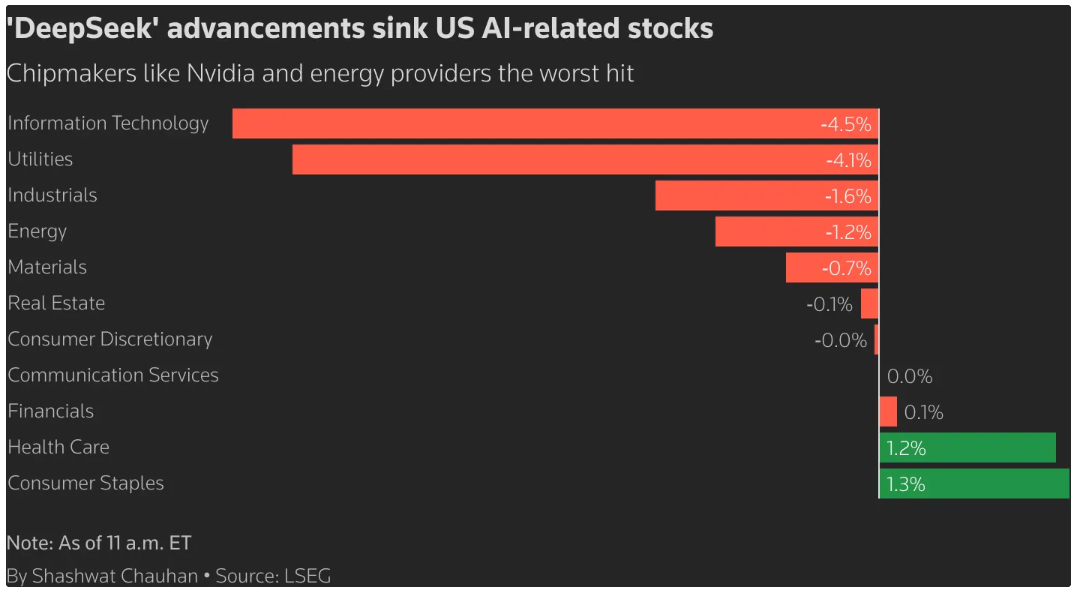- Roko's Basilisk
- Posts
- How China Is Building Its AI Internet
How China Is Building Its AI Internet
Plus: Claude gets smarter, OpenAI marriages, and three surprisingly useful AI tools.
Here’s what’s on our plate today:
🇨🇳 China’s not chasing in the AI race. It’s building a parallel ecosystem.
🗞️ ChatGPT marriages, AI vs. neuroscience, Nvidia rebounds.
🛠️ Claude’s memory, Perplexity Pages, TabHub for tab chaos.
📊 Should the U.S. allow AI chip exports to China?
Let’s dive in. No floaties needed…

Stop overpaying on taxes in 2025.
Let’s be real: Your biggest expense every year isn’t your team or your tools.
It’s your taxes, and most high earners pay more than they should.
Written by Ankur Nagpal (who sold his last company for $250M), The No BS Guide to Paying Less in Taxes breaks down the exact strategies wealthy business owners actually use:
Smarter entities
Deduction stacking
Retirement tax hacks
And moves that 17+ more tactics to cut taxes fast
With December 31st fast approaching, now’s the time to act.
*This is sponsored content

The Laboratory
How is China faring in the AI race?
When the Second World War came to an end, two superpowers were competing for the top position in the global order. This competition, though it led to the Cold War and countless proxy wars across the globe, had an upside many at the time failed to notice.
In efforts to establish and prove their dominance in the technological race, both the U.S.A. and the Soviet Union poured billions of dollars into the space race, making it possible for the first man to walk on the moon.
Ever since the collapse of the Soviet Union, the U.S. has not had a challenger to its dominance. However, in the AI race of 2025, things are quite different.
In the race that could redefine human and computer interactions forever, the U.S. is facing stiff competition from China.
China has emerged as one of the world's leading AI powers, competing directly with the U.S. across research, commercialization, and deployment. The country is also making strides in large language models, and is touted to be in the lead when it comes to certain AI applications like surveillance and facial recognition.
However, while on the surface the competition between the U.S. and China may look like a race, below the surface, it is being defined not by technological capability but by strategic choices around openness, regulation, and geopolitical alignment.
China’s early bet on AI
China’s modern push into artificial intelligence took shape in 2017, when Beijing unveiled its New Generation Artificial Intelligence Development Plan.
The roadmap set clear goals: reach the level of leading countries by 2020, make major technological breakthroughs by 2025, and become the world’s central hub for AI innovation by 2030.
Over the past decade, China has produced more AI research papers than any other nation, according to the National Security Commission on Artificial Intelligence, although some analysts still question the overall quality and impact of that research.
Major Chinese companies such as Baidu, Alibaba, Tencent, and ByteDance have poured resources into AI labs and now compete with American tech leaders like OpenAI and Google in developing advanced models.
The chip war and China’s response
The global balance shifted in October 2022 when the Biden administration introduced strict export controls on high-end AI chips and semiconductor tools needed for training large models.
These rules, which were tightened further in 2023 and 2024, cut off China’s access to Nvidia’s A100 and H100 chips that power most state-of-the-art AI systems.
However, despite the restrictions, China has managed to carve a path for its AI aims.
DeepSeek and the AI boom in China
In January 2025, Chinese startup DeepSeek launched a free AI assistant that it says uses less data at a fraction of the cost of incumbent services. Within days, the assistant had overtaken U.S. rival ChatGPT in downloads on Apple’s app store.
This caused the tech-focused Nasdaq index to drop. Nvidia’s stock value declined, falling nearly 17%, recording the largest single-day loss in market value ever seen for a U.S. company.
While the losses were soon recovered, it revealed China’s AI capabilities. The country is no longer a fast follower in AI. It had become one of two genuine AI superpowers.
In March 2025, The Economist reported that China has been experiencing an intense AI boom driven by the rapid success of DeepSeek and the launch of new models like Manus, which have sparked massive public excitement, stock-market rallies, and a rush of investment.
Companies across sectors are adopting DeepSeek’s technology, while local governments and institutions are integrating it into public services. Venture capital is pouring into AI startups despite fears of a bubble, and the central government has announced a 1 trillion yuan fund to fuel tech investment.
Additionally, it also shared that major tech firms, including Alibaba, Baidu, Huawei, and Tencent, are racing to build more powerful models and expand cloud infrastructure. Demand for AI-tailored servers and data-center capacity is surging, boosting hardware suppliers throughout China.
On the hardware front, Huawei is planning to begin mass shipments of its advanced 910C chips. And though the chip has been described more as an architectural evolution rather than a technological breakthrough, it has managed to achieve performance comparable to Nvidia's H100 chip by combining two 910B processors into a single package through advanced integration techniques.
Though the report shared that analysts warn the optimism may not last, many companies benefiting from the rally may not see sustained profits, and China’s access to advanced semiconductors remains a major vulnerability. Things have changed drastically since then.
According to recent reports from Reuters, the current U.S. administration under Donald Trump is considering greenlighting sales of Nvidia's H200 artificial intelligence chips to China.
This points to a softer stance toward China. The H200 offers more high-bandwidth memory than the H100, enabling faster data processing, and is estimated to be about twice as powerful as Nvidia’s H20, the most advanced chip the U.S. still allows China to buy.
The development comes at a time when it is becoming increasingly clear that the AI race narrative, where winner-takes-all, may not be the right analogy to describe the U.S. and China’s push to develop advanced AI models.
Two competing AI ecosystems emerge
The reality in late 2025 is a bifurcation into two distinct ecosystems. While the US retains a decisive lead in fundamental research, high-end silicon (GPUs), and private venture capital, China has successfully pivoted toward an application-first strategy.
As the competition between the two nations intensifies, the world appears to be splitting into two separate technological ecosystems: a Western one built on Nvidia hardware and OpenAI software, and an emerging Eastern one powered by Huawei chips and Chinese-developed frameworks.
This divide means global companies may soon be forced to choose which system to commit to, adding new layers of complexity to international technology planning.
China’s strengths and weaknesses
China has made rapid progress, but its tightly controlled internet remains a key obstacle. Without access to the full range of global data, its models may struggle to match the reasoning capabilities of those developed in the United States.
Even so, China is well placed to shape the broader AI landscape. Its low-cost, efficient models that run on non-restricted hardware could become the preferred choice across the Global South. China may not lead in cutting-edge AI, but it could still dominate everyday AI adoption worldwide—a form of influence that matters just as much.
When the Soviets launched Sputnik in 1957, Americans thought they had a technological race. However, as it turns out, the Sputnik was just the catalyst the Americans needed to put Neil Armstrong on the moon.
Today, both China and the U.S. are pushing each other to continue breaking the barriers of what machines were thought to be capable of. Who knows, maybe this time humanity might actually encounter alien intelligence, one developed and trained on its data, but alien nonetheless.


Quick Bits, No Fluff
ChatGPT and marriage drama: Couples are citing ChatGPT in divorce filings, either as a confidante, a wedge, or both. AI’s entering the courtroom.
LLMs’ ≠ human brains: A new paper argues that large language models may simulate intelligence but don’t solve real cognitive problems. Neuroscientists aren’t convinced.
Nvidia stock dips on chip report: Shares slid after a report revealed Google and Meta might be building their own AI chips, raising long-term questions for Nvidia.

Launch fast. Design beautifully. Build your startup on Framer—free for your first year.
First impressions matter. With Framer, early-stage founders can launch a beautiful, production-ready site in hours. No dev team, no hassle. Join hundreds of YC-backed startups that launched here and never looked back.
One year free: Save $360 with a full year of Framer Pro, free for early-stage startups.
No code, no delays: Launch a polished site in hours, not weeks, without hiring developers.
Built to grow: Scale your site from MVP to full product with CMS, analytics, and AI localization.
Join YC-backed founders: Hundreds of top startups are already building on Framer.
Eligibility: Pre-seed and seed-stage startups, new to Framer.
*This is sponsored content

Thursday Poll
🗳️ Should the U.S. allow Nvidia to sell H200 chips to China? |

3 Things Worth Trying
Perplexity Pages: Turn any AI search into a shareable, structured page. It’s like Notion met a research assistant.
Claude 2.1’s Memory Mode: If you haven’t played with Anthropic’s persistent memory yet, this is the most ‘long-term assistant’ any chatbot has ever felt.
TabHub AI: The Chrome extension that turns your tabs into searchable, summarizable sessions. Chaos tamed.
Meme Of The Day

Rate This Edition
What did you think of today's email? |





